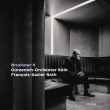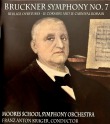Torring, Ebbe: Essay & Appendix on Recapitulations in Bruckner Symphonies
|
Torring, Ebbe: Recapitulation Procedures in Bruckner's SymphoniesEbbe Torring In his book The Essence of Bruckner, Robert Simpson makes the following observation: "... so far as form is concerned, no two movements of this composer closely resemble each other, and he rarely makes a move without a purpose suited only to the matter in hand."[1] And Theodor Adorno, in his book on Mahler, writes that "the recapitulation was the crux of the sonata-form."[2] Over the years I have become increasingly fascinated by the various solutions Bruckner found to this specific problem, in particular the transition from development to reprise; and it strikes me that his recapitulation procedures lend themselves to demonstrating the variety and the diversity of his symphonic oeuvre. At the Bruckner Symposion in 1996, William Carragan described Bruckner's sonata-form movements as follows: "Bruckner thought of sonata-form movements as bipartite, with Part I comprising a classical (but tri-thematic) exposition and Part II the development, recapitulation and coda. He applied this concept to first movements and finales alike. Within this form, as the years went by, Bruckner tended more and more to blur the distinction between development and developed reprise of the first subject, and the listener must seize upon the recurrence of the second subject as the first unmistakable evidence of formal recapitulation."[3] And according to Benjamin Korstvedt: "It is in the recapitulation ... that Bruckner breaks most decisively with formal convention. [...] In his earlier symphonies, up to the Fourth, Bruckner's handling of the initial portion of his recapitulations is quite regular, with the reprise beginning with a 'simultaneous return' [of both primary theme and tonic key] prepared by a dominant preparation " [with] the development section [coming] to rest on the dominant."[4] In the earlier symphonies the recapitulation in its design follows the thematic sequence of the exposition, whereby an overall symmetry is created. But "Bruckner's methods [...] evolved substantially in the late 1870s." With the Fifth Symphony and the 1880 finale of the Fourth "new strategies emerge around the juncture at the beginning of the recapitulation."[5] The most conspicuous feature of this new concept is a weakening of the recapitulation moment as such and a subsequent dynamic consolidation of the recapitulatory course as a whole; the concept is oriented towards the coda, thus giving the sonata-form a final accent. What happens is a shift from a conventional and clear recapitulation moment to a more vague drafting of this central joint. What can be observed from now on is a seamless transition from development to reprise " a weakening of the reprise moment where the reprise of the main theme is not clearly marked. In his doctoral thesis Bo Marschner wrote that "in the later part of his production the composer developed certain, personally typical, formal procedures, the most characteristic example of this being a blurred transition to the recapitulation in the outer movements, where the reprise is not really marked until the return of the second theme-group."[6] What can be observed is "the weakening or, in a few exceptional cases, the almost demonstrative elimination of the traditional main theme reprise."[7] The recapitulation also offers examples of developmental treatment and, on the whole, a tightening of the theme groups compared to the exposition. It thus has not only a recapitulatory, but also a developmental function. This all contributes to giving the recapitulation what Marschner calls "a dynamic function within the formal context, at the expense of its tectonic, purely symmetrical status."[8] And this dynamic function consists in an impetus towards the coda as the part of the movement which brings the fulfilment, in the shape of the return or breakthrough of the principal theme " in the finales: the principal theme of the first movement, which Bruckner himself referred to as das Thema. The sonata-form thus acquires an end-oriented accent. These general observations form the background to the following examination of some individual cases: In the first movement of the Fifth Symphony the recapitulation is reached (at letter O, bar 363) after a 16 bar intensification passage, a Steigerung (bars 347-62), analogous to the Allegro passage in the Introduction leading up to the presentation of the main theme. In both cases the Steigerung is preceded by a chorale fragment, whose bass line is used as the motif of the Steigerung. But there are differences: in the Introduction there was a return to the original Adagio ("urspraengliches Adagio") and a sudden diminuendo, before the main theme was launched piano ; but at the end of the development the Steigerung continues in the same tempo and there is no diminuendo, with the result that the ensuing fortissimo restatement of the main theme is felt as the culmination of the preceding passage. In this way Bruckner creates a fusion between the end of the development and the beginning of the recapitulation. In the exposition the theme was presented twice " first time piano, second time fortissimo " occupying 46 bars, but in the recapitulation there is only one 18 bar restatement of it, with a sudden hush down to a piano-pianissimo before the arrival of the second theme (at letter P, bar 381). Truncation applies as a whole to the recapitulation with its 90 bars versus 154 in the exposition. After the dramatic climax of the development (starting at letter L, bar 283), followed by the heavily scored descending outbursts interspersed with tentative quotations of the second theme (starting at letter N, bar 319) the chorale from the Introduction is heard (bar 338), launching the above-mentioned Steigerung and the transition to the reprise. " The music example begins with the chorale (bar 338). (Music example: V/1, bars 338-88 (Wiener Philharmoniker " Nicolaus Harnoncourt)) The first movement of the Sixth offers a similar solution: the fortissimo pre-reprise of the main theme in the tritone key of E flat major (starting at letter M, bar 191) is the formal transition to the genuine forte-fortissimo recapitulation in A major (at letter N, bar 209), which again comes as a culmination; and again there is a fusion between development and recapitulation. But the main theme appears twice: first time fortissimo, second time pianissimo " where in the exposition it was the other way round. The finale of the Fifth is unique in that it combines sonata and fugue. The development uses the energetic main theme and the solemn chorale from the exposition epilogue, and these two themes are developed in a single fugue on the chorale and a double fugue on both themes. Towards the end of the development (bar 349, four bars before letter P) there is a short break, and from now on the music moves towards the recapitulation: after a loud outburst of the two subjects in stretta (bar 350) the fugal activity proper gradually comes to an end, and the rhythm of the main theme initial enters (bar 362) to launch a Steigerung, which at letter Q (bar 374) culminates in a loud restatement of the main theme combined with the chorale, which is perceived as the recapitulation. However, after only four bars the thematic element yields to a free developmental passage including a new rising Steigerung, which at its peak turns and descends ritenuto and diminuendo to pianissimo, ending with a quiet fifth in augmented values (bar 396). Thus the reprise feeling is denied by some important factors: the simultaneous presence of both themes, the instant moving away from the thematic, and the dynamic developmental character; and for these reasons I do not see this passage as the beginning of the reprise, rather as the culmination of the development, a final triumph, which effectively puts an end to the adventures of the development " and which, in its concluding quiet bars, where the activity comes to a halt, inaugurates the real recapitulation, which then begins with the second theme (at letter R, bar 398). In particular the third theme group is given a dynamic and developmental treatment, including the re-introduction of the main theme from the first movement. " The music example begins with the loud outburst (in bar 350), continues via the Steigerung (from bar 362) into the culmination passage (starting at letter Q, bar 374) and further into the second theme, the real recapitulation (letter R, bar 398) (Music example: V/4, bars 350-413 (Cleveland Orchestra " Franz Welser-Moest)) And now to the finale of the Fourth in its third version from 1880. It is not fugal, of course, but in its recapitulation strategy it offers some resemblance to the finale of the Fifth. In the Second Part of the movement the main theme occurs twice in a recapitulatory manner: the climax of the development begins fortissimo at letter M (bar 295) with a shortened restatement of the beginning of the movement, which leads to a false reprise of the main theme in the remote key of E minor ('remote', since the movement begins in E flat minor and ends in E flat major). The triplet figure of the theme evolves into a free brass chorale, which gradually fades out and is followed by an elegiac development epilogue, based on the main theme (bars 351-82). And then suddenly " at letter P (bar 383) " the main theme bursts out loud in E flat minor, signalling the recapitulation. But the reprise function is immediately called in question by some significant factors: the main theme is not restated in its entirety, only rudimentally, and after four bars it leaves the tonic and moves to remote regions (bars 387-91); then there is a 12-bar non-thematic acceleration of the tempo, rising in chromatic steps, followed by an 8-bar deceleration, but still on the same loud level. This heavily-scored passage, which has a notoriously developmental character, ends with a long rest, after which follows the restatement of the second theme (at letter Q, bar 413), and with this the real feeling of recapitulation installs itself. " The resemblance to the corresponding passage from the finale of the Fifth should be self-explaining, but there are significant differences: in the Fifth the passage grows naturally from the preceding material and functions, not as a recapitulation, but rather as a culmination of the development, and it ends quietly, leading naturally into the restatement of the second theme, whereas here in the Fourth the loud passage enters extemporaneously, opening not a real recapitulation, but a pseudo-recapitulation, which rather has the effect of an unintegrated appendage to the development. The third theme group is not restated: after the second group follows a recapitulation epilogue before the coda. " The music example brings the false reprise, the brass chorale, the development epilogue, the pseudo-recapitulation and the beginning of the genuine reprise with the second theme. (Music example: IV/4 (1880), bars 295-426 " (Orchestre des Champs-Élysées " Philippe Herreweghe)) The finale of the Sixth also offers a rudimental restatement of the main theme: After an 8 bar reprise rudiment (letter Q, bar 245) follows a 45 bar developmental passage (bars 253-98), and again the clear recapitulation stage is reached with the restatement of the second theme (at letter T, bar 299). Now a few words about the fourth version of the Finale of the 'Romantic', which in Ferdinand L we's adaptation was checked and approved by the composer in 1888. The most conspicuous change in comparison to the third version is that the pseudo-recapitulation is eliminated, which means that the music goes directly from the main theme based sequence of 'false reprise, chorale, development epilogue' to the reprise of the second theme. In an article in 'The Bruckner Journal' from November 2001 David Aldeborgh wrote about the 1888 finale: "With respect to form, the recapitulation of the first theme is eliminated " and since some authors characterize this as a 'mutilation', it deserves some comment. In the 1878-80 version, this recapitulation appears as a completely disconnected and very loud brass enclave which, musically speaking, goes absolutely nowhere. It utterly fails to function in a true sonata-form manner, namely as a welcome return to home territory from which the development has led away [...]. But because the sonata form requires a restatement of the first theme, Bruckner stuck it there; I can see no other reason for its presence."[9] I tend to agree. After the preceding main theme based course a new restatement of the main theme seems redundant, and the omission of the 'loud brass enclave' secures a smoother and more organic transition from development to recapitulation. According to Ben Korstvedt, the recapitulation epilogue and the 'loud brass enclave' was a passage which Bruckner consistently tinkered with and even asked the conductor Felix Mottl to leave out. " The music example begins with the development epilogue, leaves out the 'loud brass enclave' and goes directly to the reprise of the second theme. A similar pattern is seen in the 1889 finale of the Third Symphony, which was prepared by Franz Schalk and thoroughly overhauled, changed and approved by the composer. As Bo Marschner has pointed out[10], Loewe and Schalk seem to have used the finale of the Seventh as a guideline in their respective revisions of the Fourth and the Third. Common to all three finales is that the main theme is eliminated as the marker of the recapitulation, which begins instead with the second theme, and the third theme group is missing as a self-contained element in the recapitulation. It should be noted that Marschner finds the finale of the Seventh more successful than the two adapted ones. In the first movement of the Eighth " and I shall confine myself to the second version with its unique hushed ending " you find the exact opposite of a 'loud brass enclave': the restatement of the principal theme begins almost unnoticed in bar 283 (four bars after letter P), entrusted to the frail solo-oboe, taken over by the clarinet and later by trumpets and violins, and you do not immediately realize that the recapitulation has begun. I am well aware that scholars disagree as to where the recapitulation begins: some believe in bar 225 (letter L), and others (including myself, in all modesty) in bar 283. What happens in bar 225, is the dramatic climax of the development, consisting of a powerful threefold collision between the augmented initials of the main theme and the inverted second theme. The passage is the culmination of a mighty escalation on the inverted second theme in the Bruckner rhythm (2 against 3) starting at letter K (bar 193). Between the first and the second, and between the second and the third collision is heard what Bruckner referred to as the Todesverk ndigung ('the annunciation of death'), i. e. the rhythmic skeleton of the main theme initial. This threefold thematic collision functions as a moment of peripety, a turning point, after which the main theme is left in a weakened state. In the pianissimo passage after the third collision the 'death annunciation' is heard again, accompanied in cellos and basses by the chromatic descending tail of the main theme initial, which also ends the movement. Without advocating any programmatic reading in a wider sense, it is my assertion that the 'death' which is 'annunciated', is the 'death' of the main theme. The following passage (from letter O, bar 263), which is based i.a. on the tail of the main theme initial and derivatives thereof and where also the 'death annunciation' is heard on the trumpets, is a borderland between the development and the recapitulation, leading to a faint and subdued revival, i.e. reprise of the main theme in bar 283, where the oboe, barely audible, announces the beginning of it; it is not until a little later, when it is taken up by the trumpets and the violins, that the recapitulatory status becomes evident. The theme fades out, and is only restated once, as compared to the double statement in the exposition. The second thematic group is equally shortened. But the third group, which in the exposition via a climax led to a hushed epilogue of the main theme initial, is expanded by 20 bars, consisting in a loud and violent outburst of the Todesverk ndigung, at last only in horns and trumpets, after which the coda brings the main theme initial in pianissimo, spinning out its chromatic descending figure, and the movement comes to a hushed standstill " the complete extinction of the main theme. As is well-known, Bruckner used the words Totenuhr ('death knell') and Ergebung ('surrender') about this coda. So much for the narrative of this movement. " The music example begins at letter K (bar 193) with the Steigerung on the inverted second theme leading to the thematic collision at letter L (bar 225), continues with the low-powered passage (letter N, bar 249) and goes through the 'borderland' transition (from letter O, bar 263) into the recapitulation with the oboe restatement of the main theme (starting in bar 283). (Music example: VIII/1 (1890), bars 193-310 (Orquesta sinf nica de Venezuela " Eduardo Chibas)) And finally the first movement of the Ninth. Here the recapitulation does not begin with the main theme, but with the second theme. The narrative of the development is centred around two all-important episodes: the vigorous false reprise of the main theme initial in the middle (reminiscent of the first movement of the Third Symphony) and the shattering blow administered to it at the end. The false reprise (starting at letter L, bar 333) comes as the climax; it consists of three consecutive waves, and happens as the culmination of an escalation passage similar to the one leading to the breakthrough of the main theme in the exposition (bars 51-62). The following section (letter O, bar 355), a demonic march based on the triplet figure from the main theme initial in inversion and diminution, leads to the final and decisive section (letter P, bar 367), which again is pervaded by the triplet figure, and which ends with a loud and dramatic culmination passage (starting in bar 380), whose crucial factor is the shattering blow administered to the main theme " accomplished in the descending tenth leap in the brass group (bar 391-4). The volume goes down, and after a rest, bridged by the kettledrum, begins langsamer in pp at letter R (bar 399) the development epilogue, which is based on the triplet motif of the main theme and in a long, mournful descending line, played by the strings over a timpani roll, seals the defeat of the theme. At the beginning of this passage the theme rears its head, as it were, but after 21 bars no life is left: in the first bars is heard a rising sequence of the triplet figure followed by the octave leap; at the peak the octave leap is dropped, and soon the descent over two octaves happens in a long unbroken row of triplets, where the triplet feeling gradually fades away, and which in the last four bars are augmented: the motion comes to a standstill. At this point it would be impossible to start the recapitulation with the main theme, and it is thus the second theme which after a rest launches the recapitulation proper (at letter S, bar 421). Compared with the exposition, the reprise of both the second theme and the third theme is shorter, whereby the end of the latter via a Steigerung reaches a huge climax before the chorale transition into the coda. " The music example starts in bar 321 with the build-up to the false reprise (at letter N, bar 333), continues with the demonic march (letter O, bar 355) and the decisive section (letter P, bar 367) leading to the 'shattering blow' (bar 391-4) and goes via the development epilogue (letter R, bar 399) into the recapitulation launched by the second theme (letter S, bar 421). (Music example: IX/1, bars 321-428 (Minnesota Orchestra " Stanislaw Skrowaczewski)) [1] Robert Simpson: The Essence of Bruckner " first published 1967, revised edition (used here) London 1992, p. 35. [2] Theodor W. Adorno: Mahler. Eine musikalische Physiognomik " Frankfurt a.M. 1960, p. 127. [3] William Carragan: Structural Aspects of the Revisions of Bruckner's Symphonic Finales, in: Bruckner Symposion 1996 " Fassungen, Bearbeitungen, Vollendungen " Bericht. Linz 1998, pp. 177-187, here p. 179. [4] Benjamin Korstvedt: Aspects of Bruckner's Approach to Symphonic Form, in: The Cambridge Companion to Bruckner (Cambridge University Press 2004), p. 180, 181. [5] Ibid., p. 182 [6] Bo Marschner: Zwischen Einf hlung und Abstraktion. Studien zum Problem des symphonischen Typus Anton Bruckners (Habilitationsschrift) ("Between Empathy and Abstraction " Studies in Bruckner's Symphonic Type"). Aarhus 2002, p. 24. [7] Ibid. p. 369. [8] Ibid. p. 334-5. [9] David Aldeborgh: Austerity versus Charm: Revisions in Bruckner's Fourth and First Symphonies, in: The Bruckner Journal, November 2001, pp. 26-31. [10] Bo Marschner: Die letzte Fassung (1889) von Anton Bruckners 3. Sinfonie. Ein Problemfall in der kritischen Gesamtausgabe, in: Neue Berlinische Musikzeitung 8 (Berlin 1993), pp. 22-32. Ebbe Torring Allerod (DK), April 2009 (Posted 5/5/2009 by admin) |








